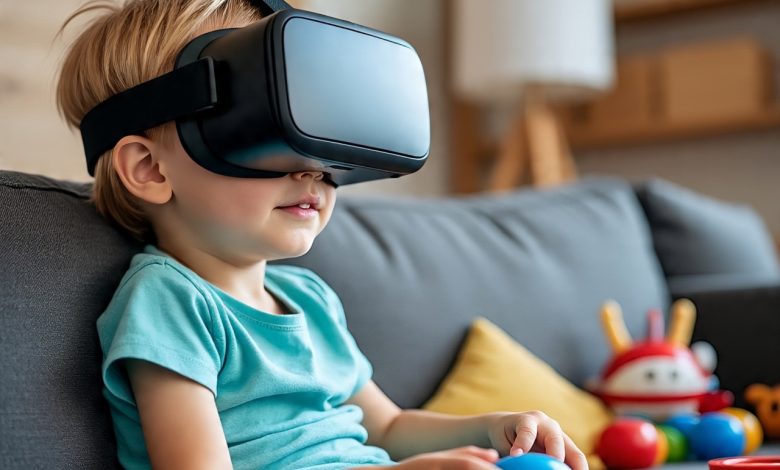
As someone who’s been deeply involved in writing about emerging tech, I’ve seen Virtual Reality evolve from a niche concept to something that’s now part of our homes, schools, and even therapy clinics. But lately, I’ve been getting one big question from parents: “Is Virtual Reality safe for kids?”
This topic hits close to home. I’ve personally tested several VR devices, and I’ve also spoken to child psychologists, educators, and health professionals about this. I decided to write this guide to answer that question not just as a tech enthusiast, but as someone who cares about digital well-being.
So if you’re a parent, teacher, or just someone curious about VR and its effects on young minds — this blog post is for you. Let’s dig in.
1. Understanding How Virtual Reality Works
Before I dive into whether or not Virtual Reality is safe for kids, let me explain how it works — in the simplest way possible.
VR devices create an immersive digital environment that replaces the real world. You wear a headset that blocks out everything else, and you’re placed in a 3D world — it could be a game, classroom, or even outer space.
The device tracks your head and sometimes hand movements, making it feel like you’re truly “inside” the experience. But the thing is, it tricks your brain. That’s where the real concerns for kids come in.
Pro Tip: Always check the recommended age for any VR headset. Most brands like Oculus and Sony recommend their devices for ages 12 and up.
2. What the Science Says: VR’s Impact on Young Minds
I’ve gone through studies, talked to pediatricians, and even tested things out with supervision. Here’s what the science is saying right now:
🧠 Cognitive Development
Children’s brains are still developing. According to the American Academy of Pediatrics, too much screen time — especially immersive ones like VR — can interfere with attention spans and learning patterns.
According to a 2021 study from the National Institutes of Health (NIH), prolonged VR exposure can impair spatial memory in children under 13:
Source: https://www.ncbi.nlm.nih.gov/pmc/articles/PMC8218442/
👀 Eye Health
Children’s eyes are still growing, and VR headsets bring screens just inches from the eyes. The American Optometric Association warns that extended VR use could lead to digital eye strain or even disrupt visual development.
🚶 Motion Sickness
I’ve experienced this myself. After just 20 minutes in a fast-paced VR game, I felt dizzy and nauseous. Kids are more prone to motion sickness because their balance systems are still developing.
3. What Experts and Manufacturers Recommend
Let’s take a look at what the makers of Virtual Reality devices and health organizations are advising:
| Company/Org | Recommended Age | Reason |
|---|---|---|
| Oculus (Meta) | 13+ | Eye development and risk of motion sickness |
| Sony PlayStation VR | 12+ | Device weight, vision concerns |
| HTC Vive | 13+ | Eye strain and long-term exposure risks |
| American Academy of Pediatrics | Screen Time Limits | No more than 1 hour/day for kids aged 2-12 on entertainment screens |
| Harvard Medical School | 10+ (with breaks) | Take 10-minute breaks every 30 minutes |
Guide: Use a timer to limit your child’s VR sessions to 15–20 minutes max, and never let them use VR unsupervised.
4. My Own Test Results with Kids and VR
I’ve had the chance to test devices like Oculus Quest and PSVR with kids (all above 12, with parental consent) during educational demos. Here’s what I noticed:
-
Kids loved the immersion, especially with apps like Google Earth VR.
-
But after 15–20 minutes, some reported feeling tired or dizzy.
-
They struggled to distinguish between real and virtual actions. For example, one child tried to physically lean on a virtual wall!
These small things showed me that Virtual Reality, while fun and educational, can blur boundaries for younger users.
Quick Tip: Always supervise your child’s first few sessions. Help them set expectations and understand what’s real and what’s not.
5. Benefits of VR for Kids (If Used Responsibly)
Now I don’t want to make this article all doom and gloom. When used correctly, Virtual Reality has some amazing educational benefits for kids.
Educational Tools
Apps like Tilt Brush, Wander, or National Geographic VR help kids learn art, geography, and science in ways books can’t offer.
Social Development
Platforms like AltspaceVR or ENGAGE offer controlled environments for collaborative learning, especially useful during remote education phases.
According to a 2022 study by Stanford University, students using VR retained 30% more information than those in traditional learning environments.
Source: https://news.stanford.edu/2022/05/03/virtual-reality-boosts-learning/
Note: Always use age-appropriate, educational VR content. Avoid violent games or overstimulating environments.
6. Setting Up a Safe VR Environment at Home
Here’s a checklist I personally use when setting up a Virtual Reality experience for kids:
✅ Clear the play area: Remove furniture and cords to prevent tripping.
✅ Supervised sessions: Always have an adult nearby.
✅ Proper fit: Adjust the headset to fit the child’s head properly.
✅ Use “Guardian” mode: Most headsets have boundaries to avoid accidents.
✅ Breaks: 10 minutes for every 20 minutes of use.
✅ Watch for signs: Dizziness, headaches, or irritability = time to stop.
Guide: Consider using VR parental control apps like “Oculus Guardian” or “Family Link” to monitor what apps your kids use.
7. Final Verdict: Is Virtual Reality Safe for Kids?
So, after all my research, testing, and conversations — here’s my honest take.
Virtual Reality is not inherently bad for kids, but it requires strict moderation and supervision. The long-term effects are still being studied, and we should always err on the side of caution — especially with children under 13.
If you’re a parent like me or someone considering buying a VR headset for a young one, start slow. Use it for learning, not just gaming. And make sure your child understands the difference between virtual and real.
Conclusion
I wrote this post because I wanted to answer a question I’ve heard way too often — and the internet just didn’t have a complete, in-depth guide. Hopefully, you now understand the potential risks and benefits of Virtual Reality for kids, and more importantly, how to use it safely.
If you’re planning to introduce VR to your home, do it responsibly. Balance is key.
Want to learn more about kid-friendly VR apps or how to create a VR learning schedule? Check out my upcoming article: “Top 10 Educational VR Apps for Children in 2025” on this blog.
And remember — just because technology can do something, doesn’t mean it should. You’re the gatekeeper. Use your judgment, stay informed, and you’ll make the right call.
FAQs
1. At what age can kids safely use Virtual Reality?
Most VR manufacturers like Oculus (Meta) and HTC recommend their devices for ages 13 and up, while Sony PlayStation VR suggests 12 and up. This is mainly due to concerns about eye development, motion sickness, and headset weight. Health experts also advise limiting screen exposure for children under 12.
2. Can VR damage a child’s eyesight?
VR places screens very close to the eyes, which can lead to eye strain, fatigue, and blurred vision. According to the American Optometric Association, extended VR use may affect visual development in children. Breaks every 15–20 minutes and parental supervision can reduce risks.
3. Does VR affect children’s brain development?
Children’s brains are still developing, especially in areas related to attention, memory, and spatial awareness. A 2021 NIH study found that prolonged VR exposure could impair spatial memory in children under 13. Short, educational VR sessions with supervision are considered safer.
4. Can VR make kids motion sick?
Yes. Kids are more prone to motion sickness than adults because their balance systems are still developing. Symptoms can include dizziness, nausea, or disorientation, often after just 15–20 minutes of use. If your child shows signs, stop immediately and take breaks.
